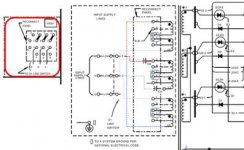Family_van
Plastic
- Joined
- Mar 30, 2017
Here we go. I am working toward converting my Lincoln CV300 to 1 phase using the Haas-Kamp conversion. Thanks to all of you who have contributed their findings. I have followed the pounceatron (THANK YOU!) version CP200 diagram.
Here are the steps I have taken:
•I have hooked up the A coil on the primary side, the B coil with capacitors, and the C coil has been hooked up reverse of A.
•I have disconnected all of the windings on the primary coil that bridge the coil (original CV-300 #s 10,11,12).
•I have disconnected all the circuit boards and low voltage connections.
•I believe that the CV300 is actually Y already but I did disconnect the secondary bridge. (How do I really know if I have a y or delta without power????)
Results
When I fire it up it just trips the breaker anywhere from immediately to within 2 seconds. Not fast enough to get a voltage reading. Not sure where to go from here. Any thoughts?
I do notice that the output capacitors on the CV300 are after the SCR whereas the CP200 capacitors are before the SCR’s.
Note: I do have the welder hooked up to a 2p20 breaker but I would think where I am not drawing welding current I should be able to test it.
I have attached my modified drawing with how I have wired the CV300 and also copy of the original drawing of the transforming wiring.
Thanks!
Here are the steps I have taken:
•I have hooked up the A coil on the primary side, the B coil with capacitors, and the C coil has been hooked up reverse of A.
•I have disconnected all of the windings on the primary coil that bridge the coil (original CV-300 #s 10,11,12).
•I have disconnected all the circuit boards and low voltage connections.
•I believe that the CV300 is actually Y already but I did disconnect the secondary bridge. (How do I really know if I have a y or delta without power????)
Results
When I fire it up it just trips the breaker anywhere from immediately to within 2 seconds. Not fast enough to get a voltage reading. Not sure where to go from here. Any thoughts?
I do notice that the output capacitors on the CV300 are after the SCR whereas the CP200 capacitors are before the SCR’s.
Note: I do have the welder hooked up to a 2p20 breaker but I would think where I am not drawing welding current I should be able to test it.
I have attached my modified drawing with how I have wired the CV300 and also copy of the original drawing of the transforming wiring.
Thanks!





